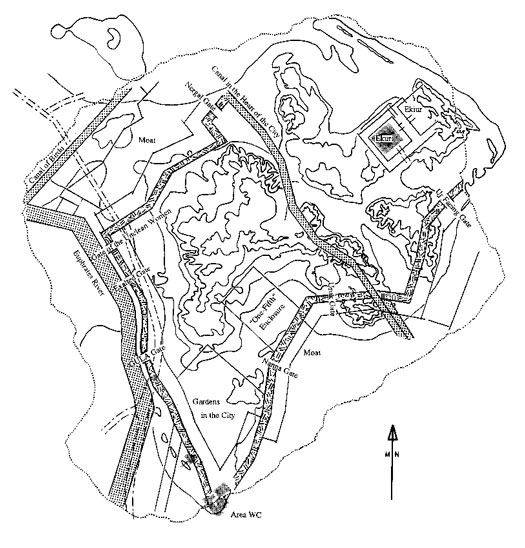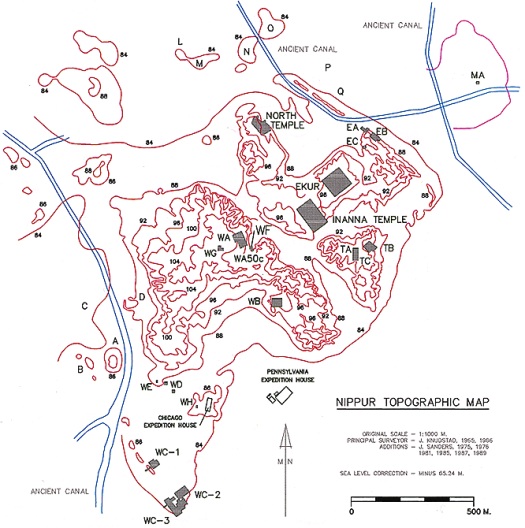Resources
Oriental institute Page on Nippur.
- See esp "Nippur - Sacred City Of Enlil: Supreme god of Sumer and Akkad" article by McGuire Gibson.
- Archaeological site photographs of Nippur.
Bibliography
Sallaberger, Walther; 1997. “Nippur als religiöses Zentrum Mesopotamiens im historischen Wandel,” in Die orientalische Stadt: Kontinuität, Wandel, Bruch. G. Wilhelm (ed.), SDV Saarbrücker Druckerei und Verlag: Saarbrücken: 147-168.
Zettler, Richard L.; 1987b. “Enlil’s city, Nippur, at the end of the late third millennium B.C.” BSMS 14: 7-19.
Ellis, Maria deJong (ed.); 1992. Nippur at the centennial. Papers read at the 35e Rencontre Assyriologique Internationale Philadelphia 1988. Occasional Publications of the Samuel Noah Kramer Fund 14: Philadelphia.
Zettler, Richard L.; 1992. The Ur III temple of Inanna at Nippur: the operation and organization of urban religious institutions in Mesopotamia in the late third millennium B.C. Dietrich Reimer Verlag: Berlin.
Gibson, McGuire; 1993. “Nippur, sacred city of Enlil, supreme god of Sumer and Akkad,” Al-Rāfidān 14: 1-18.
Tinney, Steve; 1996. The Nippur Lament: royal rhetoric and divine legitimation in the reign of Išme-Dagan of Isin (1953-1935 BC). Occasional Publications of the Samuel Noah Kramer Fund, 16: Philadelphia.
Lambert, Wilfred G.; 1992. “Nippur in ancient ideology,” in Nippur at the centennial. M. deJong Ellis (ed.), Occasional Publications of the Samuel Noah Kramer Fund 14: Philadelphia, 119-126.
Notes
Nippur: certain cities in Mesopotamia drew more imagination upon them, may be more permanent ones sometimes that superceded what actually was there: a collective imagination may well surpass material reality, often it replaces reality with something better than that reality. Imagination of cities, we need to consider in that context. After all archaeology is pretty much all have to do with imagination. Now read the definition.
Nippur: a mythologized city. This imagination however I would like to emphasize a collective and cumulative one: it is not an imagination of a nsingle individual, a historical actor, or that of a single moment of history.
Located in the heart of Mesopotamia on a branch of the Euphrates. Enlil’s city, the site of His sanctuary: E-kur; literally house of the land. During the lengthy centuries of Nippur’s lively social life-span from early 3rd millennium to mid-2nd millennium, no Mesopotamian states attempted to use the city as their political capital, while pretty much all sought their royal legitimacy by being recognized at Nippur. The city, its holy status, was too powerful to be politically challanged. Commissioning of building projects, continuous feed of offerings to the existing temple complexes at Nippur were part of the definition of royal ideologies for many 3rd and early 2nd millennium kings in Southern Mesopotamia. After mid-2nd millennium BC., Nippur slowly gave away its cultic, cosmic centrality to Babylon, whose image has surpassed Nippur’s afterwards.
Nippur as a locus of scribal activity: scribal schools, place of learning. A place of heterogenous literary activity where both Akkadian and Sumerian scholars were producing works.


 nippur001.jpg
nippur001.jpg